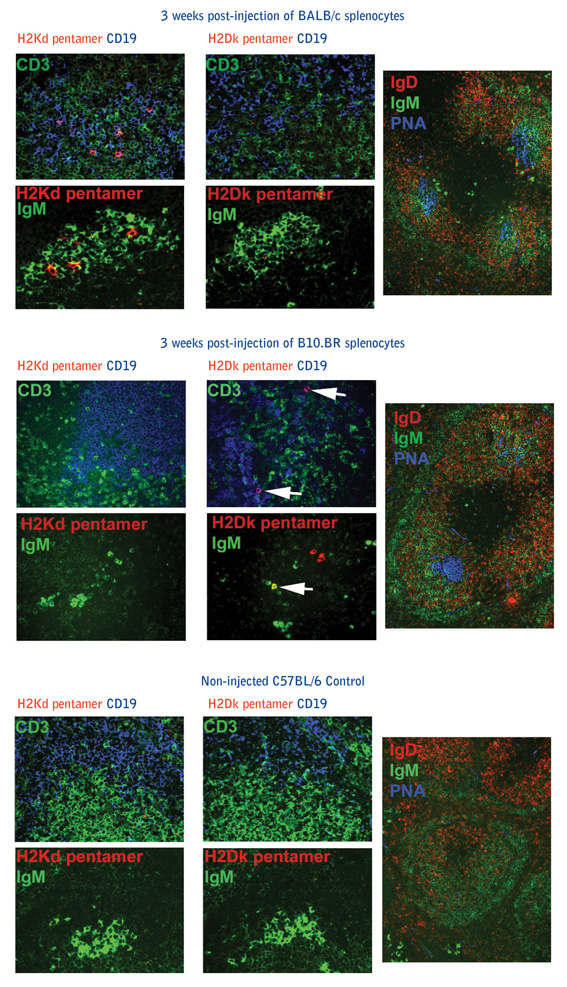Your basket is currently empty!
Tissue Staining
Tissue Staining with Pro5® MHC Class I Pentamers
Tracking Antigen-specific T Cells In Situ
Much of our knowledge of the dynamic nature of immune responses has been acquired from the use of MHC multimer technology. We now have the opportunity to broaden our understanding of the spatial and temporal relationships of immune responses by direct in situ visualization of antigen-specific T cells.
Pro5® MHC Class I Pentamers can be used to stain viable tissue sections from lymphoid organs, peripheral tissues and tumour infiltrate. By carrying out double-staining with fluorescent anti-CD8 antibody and fluorescent Pro5® Pentamers, the antigen-specific T cells can be visualized by fluorescent microscopy.
Case Study: In Situ Identification of Allospecific B Cells using Pentamers
Panoskaltsis-Mortari, A. et al., (2008). In Situ Identification of Allospecific B Cells using Pentamers. Blood. 111(3): 3904-3905. [PubMedID:18362221]
Graft rejection following bone marrow transplantation is a serious problem for patients who have undergone this treatment. Amongst other factors, the presence of preformed alloantibody is a major contributor to the failure of bone marrow engraftment.
A study by Panoskaltsis-Mortari et al. demonstrated a novel protocol using ProImmune’s Pro5® MHC Class I Pentamers to detect allospecific B cells in situ by immunohistochemistry. Splenocytes from BALB/c mice (H2d) were injected into C57BL/6 mice (H2b) that were then sacrificed after 3 weeks. Splenic cryosections were stained with an H-2Kd-specific Pentamer (GYKDGNEYI) and, as a negative control, an H-2Dk Pentamer (RRLGRTLLL). BALB/c H-2Kd specific cells were detected in the splenocyte sections, whilst there was no binding of the H-2Dk Pentamer in serial sections. As an additional control C57BL/6 mice were injected with B10.BR splenocytes (H2k). In splenic cryosections the H-2Dk Pentamer showed specific staining, whereas there was no staining with the H-2Kd Pentamer.

Data from experiment showing that allospecific B cells can be detected in situ in allosensitized murine spleen using Pro5® Pentamers. Colors for the different markers are indicated in colored text. Magnification is 400x (left and middle panels) and 200x (right panel). Copyright American Society of Hematology.
This is the first study using Pro5® Pentamers to detect allospecific B cells by immunohistochemistry. This could be an important technique to provide further information about spatial positioning of alloantibody producing cells and inter-cellular interactions. This method could also be used as a way of visualizing antigen specific T cell responses in tissues.
Publications
Huang, D. et al., (2023). Tumour circular RNAs elicit anti-tumour immunity by encoding cryptic peptides. Nature. doi.org/10.1038/s41586-023-06834-7. [PubMedID:38093017]
Serafini B et al (2019). Epstein-Barr Virus-specific CD8 T cells selectively infiltrate the brain in Multiple Sclerosis and interact locally with virus-infected cells: clue for a virus-driven pathological mechanism. J. Virology 93:e00980-19 [PubMedID: 31578295]
Serafini B et al (2018). Epstein-Barr virus-associated immune reconstitution inflammatory syndrome as possible cause of fulminant multiple sclerosis relapse after natalizumab interruption. J. Neuroimmunol 319:9-12 [PubMedID: 29685294]
Panoskaltsis-Mortari, A. et al., (2008). In Situ Identification of Allospecific B Cells using Pentamers. Blood. 111(3): 3904-3905. [PubMedID:18362221]
Christen U. et al. (2004). A viral epitope that mimics a self antigen can accelerate but not initiate autoimmune diabetes. J. Clin. Invest. 114: 1290-1298. [PubMedID: 15520861]
Skinner PJ and Haase AT. (2002). In situ tetramer staining. J. Immunol. Methods 268: 29-34.[PubMedID: 12213340].
Haanen JB, et al. (2000). In situ detection of virus- and tumor-specific T-cell immunity. Nat Med 6:1056-1060. [PubMedID:10973329]
Skinner PJ, et al. (2000). Cutting edge: In situ tetramer staining of antigen-specific T cells in tissues. J Immunol 165:613-617. [PubMedID:10878330]
